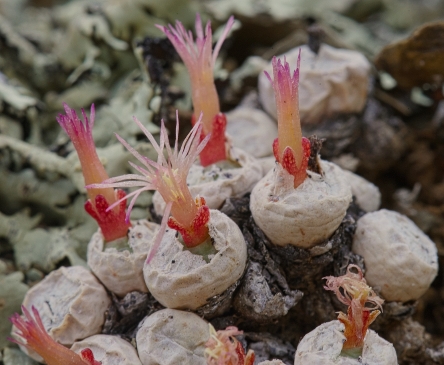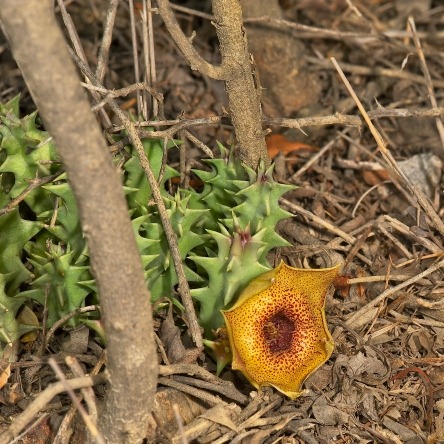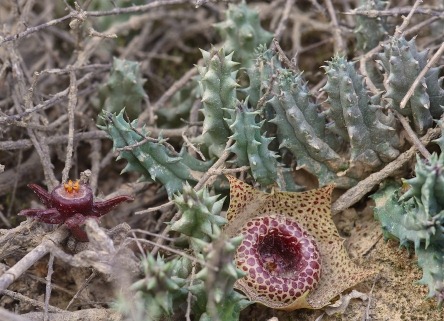
Photographed at noon on 20th April 2012 near the eastern entrance to Aneysberg Nature Reserve.
Tag: Little Karoo
Stapelia pillansii
Ornithogalum sardienii
When I first saw these little beauties on a hillside on the outskirts of Calitzdorp I had no idea what they could be, but after some searching in my library I found the original description of the species by Ernst van Jaarsveld in Bradleya 1994. Although it has since been found in a few other places and is now known to occur from Calitzdorp in the west to De Rust in the east it is considered critically rare. It grows in the shade of shrubs and often forms dense clumps. The photograph was taken in the first week of May last year.
Machairophyllums flowering after fire
In an earlier post I referred to a fire that raged on the nearby Rooiberg about a year ago.
Approximately half a year after the fire we discovered a great number of flowering Machairophyllums in the burnt areas.
Although there are several populations on the Rooiberg, we had never found a flowering specimen before and we wondered why that was. Had we never been there in the right time of the year and of the day (the flowers open after dark) or did the plants, like so many others occurring in fynbos, need a fire to trigger flowering?
Last Sunday we decided to visit the mountain again and see if we could find out if the Machairophyllums in the not burned areas had flowered so profusely last year as well. This is easy to establish because the fruits stay on the plants for a long time. We saw a couple of hundred plants in perfect condition, but only very few with (max. 2-3) fruits. If you look at the accompanying pictures (taken last October), you will see how profusely the plants flower after a fire.
All in all It seems safe to say that this species of Machairophyllum -and probably the others too- may not be totally dependent on fire to trigger flowering, but that it certainly makes an enormous difference.
When I say “this species of Machairophyllum “ you probably wonder exactly what species we are talking about here. Comparing all the information from literature, I come to the conclusion it is most probably M. albidum. Apparently other people too have a problem deciding which is which in this genus: The Illustrated Handbook of Succulent Plants recognises 7 species but also says “The genus is under study and four or five species may only be distinguishable”.
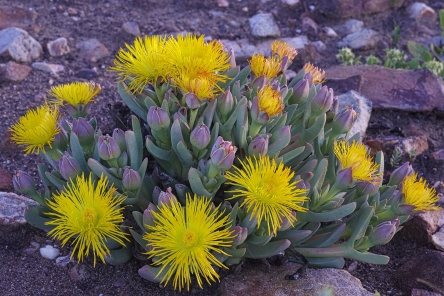
This picture was taken at 6.32 PM, when there was still just enough light to use
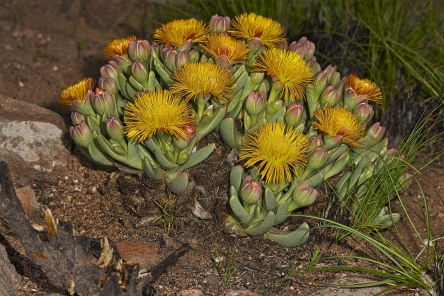
Fifteen minutes later the light had gone. so I had to use flash for this and the next two pictures
An outstanding Huernia (Huernia praestans)
H. praestans was described by N. E. Brown in 1909 and judging from the name he gave it (praestans = outstanding; pre-eminent) he must have considered it to be something quite special. It is recorded from a relatively small area in the western part of the Little Karoo (from Montagu to around Ladismith and Vanwyksdorp).
Up to now I only know the species from one slope with a rather dense scrub vegetation between Hoeko and Ladismith, which is slightly east of the recorded distribution area.
H. praestans, east of Ladismith
When I first saw the plants, I thought they belonged to the much better known H. guttata, which occupies a wide area in the Eastern Cape and the eastern part of the Little Karoo. Its habitats from near Calitzdorp are only 40-50 kms away from the place mentioned above.
The main differences between the two species is the fact that H. guttata only has some bristles in the mouth of the tube, whereas in H. praestans they also occur on the lobes.
All in all little is known of H. praestans and it has been suggested that it is a hybrid between H. guttata and H. barbata. The latter has a very wide distribution area, from the Knersvlakte as far as Grahamstown in the Eastern Cape.

H. guttata, above (with Duvalia caespitosa) and H. barbata, Mom and Dad?
A matter of colour (Pelargonium tetragonum)
The first time a saw a plant of Pelargonium tetragonum in the wild was in the vicinity of Calitzdorp. Later on I found out that the species was rather plentiful in the area, both north and south of the village.
The plants cannot be confused with any other species, but what surprised me was the colour of the flowers.
All the many plants I had seen in cultivation had pale pink flowers with deep red stripes on the upper two petals. All the plant I saw in the wild, not just around Calitzdorp but also elsewhere, had cream flowers (with the same red stripes as in the cultivated ones).
The more I thought about this phenomenon, the more I got the idea that the plants in cultivation originated from one or a few ancestors with an aberrant flower colour.
Last months I was in the Eastern Cape looking for plants with my wife and two Belgian plant friends. While trying to find my way into a dense thicket near Uitenhage, I suddenly came across several plants of this species with beautiful pink flowers.
So clearly the flower colour has to do with the area where the plants grow. According to J.J.A. van der Walt in “Pelargoniums of Southern Africa” (1977) the species occurs ” in a strip parallel with the coast from the Worcester-Caledon districts eastwards to Grahamstown. It has also been collected further inland near Graaff Reinet and Bedford”.
In their natural habitat the plants flower from September to December.
An unexpected pleasure (Drosanthemum striatum)
A few weeks ago my friend George Hattingh, who is about as mad about succulents as I am, told me that he had seen some beautiful succulents in flower which he could not identify. They were growing on top of the Rooiberg, a little mountain range just South of Calitzdorp which you have to cross on the way to Vanwyksdorp. As the road meanders its way up, it takes you through different vegetation zones. At the lower slopes a lot of succulents are found, whereas the plateau with its moister and colder climate is covered in arid fynbos. In winter and early spring the fynbos is at its best, with many different plant in flower. This type of vegetation harbours only few succulents, but some of the ones that do grow there are rather interesting. One of the plants George had found is probably an Antimima, but these I often find difficult to name. All suggestions are welcome.

The other species was clearly a Drosanthemum, but which one? After going through the literature, the only species of which the description fitted was D. striatum. According to the “Red List of South African Plants” (2009) this is a vulnerable species with only 10 locations remaining after much its habitat has been transformed for wheat and vineyard cultivation. The distribution range is given as: Malmesbury and Worcester to Swellendam and Bredasdorp. This is well outside the Calitzdorp area (even the nearest of these places is at least a 100 kms away). This new find means that the species has a rather wider distribution than assumed; hopefully it also means that it is less vulnerable than thought.
The peculiar thing is that we never found the plants before. The most likely explanation is that -like many other fynbos plants- they only flowers after fire. Or maybe we just missed them because they were too well hidden by all the vegetation that is normally present. Even without flowers they would have been much more visible without all kinds of other plants hiding them. At this moment (about seven months after a big fire on the mountain) large patches are still almost bare, so anything colourful stands out.
Whatever the reason, it just shows that interesting botanical discoveries can still be found in this part of the world.



First post
This is the beginning of a blog that is focused on two topics. Firstly on anything that has to do with succulent plants, especially those growing in South Africa, because that is were I live.
Secondly on photographing plants, succulent or not, cultivated or in the wild.
These two things have kept me busy for many years and I have written and lectured on them for almost as long. I have the privilege of living in an area where interesting succulents grow almost on my doorstep and as I am retired I have lots of time to study and photograph them
.
Haworthia arachnoidea v. nigricans along the road near my home
I hope to provide you regularly with interesting information on these subjects. It would be great to hear from you and learn what you are interested in. Therefore I invite you to share your ideas, questions, comments and opinions with other readers.
If you would like to get some more idea of who I am and what I do, please have a look at my website www.noltee.com.
